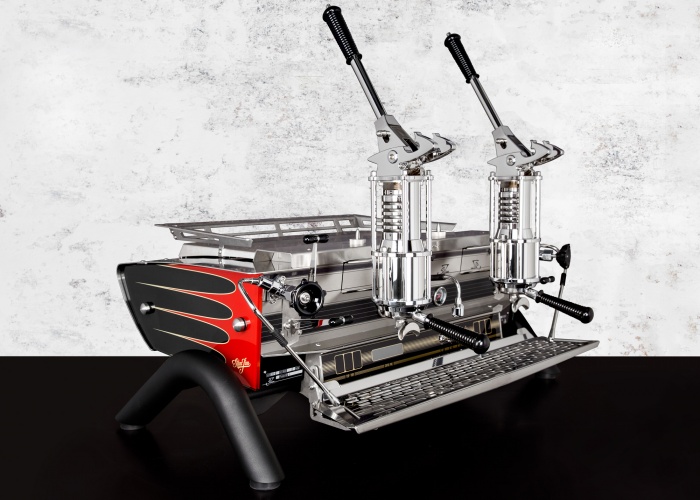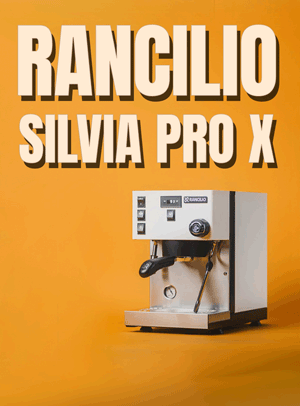Mention the name “Kees van der Westen” in high end specialty coffee circles, and people instantly know who — and what — you’re talking about. He’s recognized as one of the most serious and innovative espresso machine designers of the past few generations, and for the longest time, he was the sole innovator in aesthetic design in espresso machines. But aesthetics were not the only driving force for van der Westen; he intensely focused on the mechanics and engineering underneath the hood. Study of the espresso brewing process led him to push the technological edge on things like multiple boilers, preinfusion systems, and how pressure is applied to the water brewing espresso. He is also the world’s current leading expert on the lever brewing group, and the only one out there actively improving the design of what could be the best brewing group possible for espresso extraction.
Known to be cantankerous and contentious at times, not to mention notoriously difficult to photograph, van der Westen has softened with age, but still hasn’t lost the zeal, intensity and pursuit of espresso perfection, be it in the mechanics of espresso, the aesthetics of the machines, or the usability, putting barista in tune with the beverage produced. His company continues to innovate, and in 2019, his latest machine design — the Kees van der Westen Slim Jim — will be rolled out.
We sat down with van der Westen to talk about his history in espresso, and what the Slim Jim will bring to the espresso machine world.
Q: For maybe 2 or 3 of our readers who don’t know who you are, can you tell us when you got started in the espresso machine business, and how?
I studied Industrial Design. My last school year, which was 1984 and 1985, I had to think of a project to finish this study. By accident really I choose the espresso machine. These were all just bland boxes in those days. I saw huge possibilities!
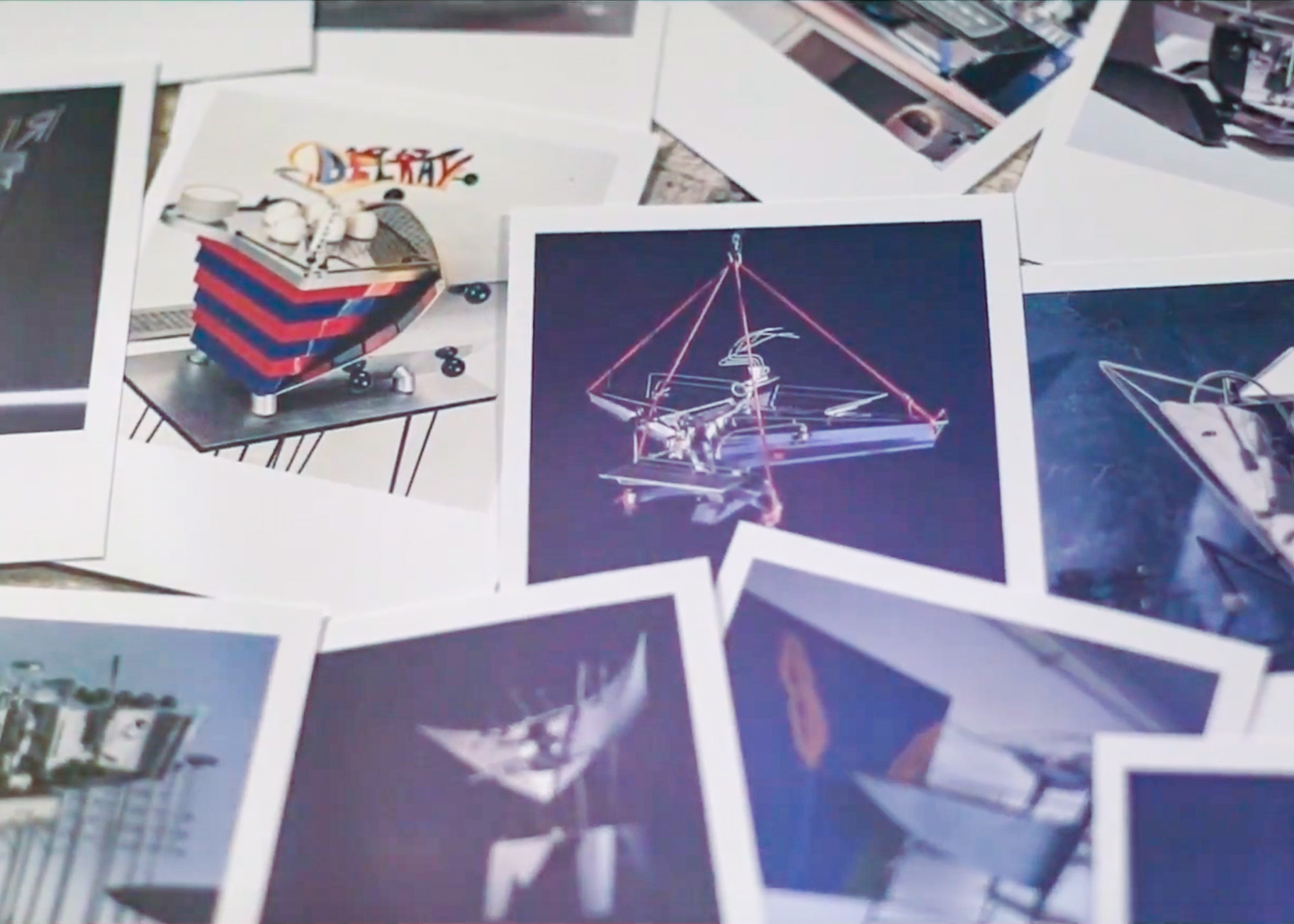
Q: Something happened between the 1950s when espresso machine manufacturers were releasing beautiful, unique espresso machines, and the 1960s when they seemed to all become boxes, as you say. Why do you think companies went to the “box” look for espresso in the 1960s and 70s, right through to the 2000s?
I suppose it was mostly due to economics. Machines had to be built in ever greater numbers, so efficiency and cost became more important. Next to this, export was becoming a far larger part for the manufacturers. The machines needed to be neutral to fit into all kinds of interiors. Less costly and unobtrusive in looks result in easier sales.
Q: You created your first two unique espresso machines while in design school, the Embezzler and the Delray Deluxe. What was the reception for those two machines both in the school, and in the espresso machine community.
The teachers were all still very much into Bauhaus. These two machines were really the complete opposite, so I did not encounter much enthusiasm. However, the Delray was actually preparing a hot and brown drink — calling it espresso would be a stretch — so that made it all right.
The espresso machine community was completely non-existent back then. This was 34 years ago, remember!
Q: Without any real community back then, where did you get feedback, your next inspiration, after the Embezzler and Delray Deluxe were built?
During the first years I was doing one-off’s only. I tried to create sculptures based around the daily savouring of a good cup of coffee with some colleagues or friends. Especially because there was hardly any awareness of good espresso — certainly not in the Netherlands back then — it made sense to go all out with these machines. A big contrast with the usual stuff was badly needed.
Inspiration for the designs came from all over: architecture, furniture design like Alchimia and Memphis Group, speedy shapes in general.
Q: When you were doing your new radical designs in the 1980s and 1990s, did you see any kind of interest from the mainstream espresso manufacturers about incorporating your design ethos into their products?
No, I never noticed any interest from the Italians. Makes sense really, they were doing thousands of machines, when I was doing one crazy piece every couple of months.
Q: Even as late as the 2000s, the mainstream espresso machine manufacturers were still producing boxes that brewed espresso; machines that seemed to portray the idea that a design aesthetic was not important for the bottom line. When do you think that started to change with the major manufacturers? Who, in your opinion, lead the way in design aesthetic from the major manufacturers?
Really do not know. They all do a bit, but I do not see any of them as more leading than the other. I reckon every one of them is focusing more and more on design.
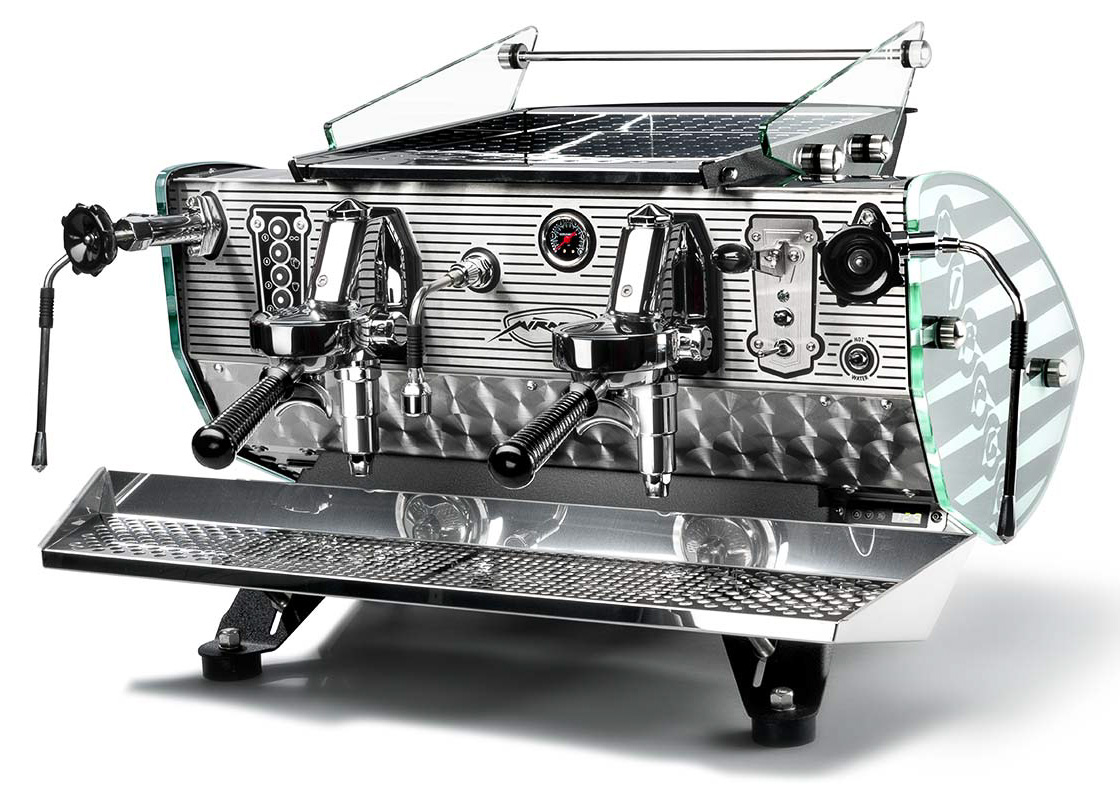
Q: You introduced the Mistral machine in the late 1990s, and the Mirage in the first few years of this new millennium. On top of being absolutely stunning machines, what made them special inside?
The first series Mistral was started in 1994. I used Marzocco components, the Linea was the only model they produced at that time. So technically the Mistral was very much a Linea with some small improvements for temperature stability.
The Mirage however, was not made with La Marzocco components, but was based on the technical set-up of the E61, with the same group head: the well-known thermo-syphon heat-exchanger with restrictor and cool-hot cross flow. I still consider this system as very efficient and technically elegant. We made our own changes and improvements to this system and it proves to be a real workhorse, offering a stable coffee water temperature plus great steam capacity.
Q: Do you consider the E61 style grouphead to be the best portafilter system out there today, or do you have a preference for other designs?
The design of the E61 grouphead, which was developed end of 1950s, was spectacularly innovative. Not just the group head itself, but mainly the thermos-siphon system inside. By combining some things that already existed separately, namely the pump, infusion chamber, heat-exchanger with constant flowing thermos-siphon action, the E61 was a revolution in 1961.
It is just sad that after all manufacturers switched to similar systems, not much development was done anymore for about 30 years. There are many possibilities to fine-tune this highly efficient set-up further. Please remember Faema was building double boiler machines with hollow groups, including their TTR or Tartaruga machine, before the E61. Faema even did multiple boiler lever groups, with a small boiler with each lever group plus a separate steam boiler, in the 1950s. So they were convinced their new E61 system was an improvement. I think it a bit sad that somehow this promising system was side-tracked by the older set-up of one boiler per function. We tried for a while to only concentrate on the E61 system with our Mirage. However, it proved impossible to convince the specialty coffee world more boilers are not needed. So in the end we decided to offer our best shot at both systems.
I’d like to mention we still offer it in our Mirage. In the new Mirage Slim Jim we use the best of both worlds, combining the thermo-siphon HX with separate boilers per group.
Q: Most people in the industry credit you specifically with re-awakening a design aesthetic mentality for espresso machines, but I also credit you with pushing the technology and theory envelope on making better espresso machines as well. Let’s talk the 2008 introduction of the Speedster; to me, that machine’s biggest wow-factor was the preinfusion system. Did you think that up? What was the goal with the Speedster’s unique pre infusion system?
The progressive pre-infusion cylinder was not invented by us, it has been used in the past by other companies. The first part of the extraction process is by far the most important. First carefully soaking the puck which softens the oils and fats, then building up pressure slowly ensures the integrity of the puck, which helps avoid channeling, and fines remain locked in position. This allows for finer grinding, giving you more and smaller particles, so more surface to easier wash oils and fats off, therefore higher yield.
Q: Which of these two machines do you consider a bigger turning point for your company: the Mirage, or the Speedster?
They both indicated turning points, but at different times. We started the Mirage in 2001. This right away was more successful than the Mistral., so that was a good step forward. The Speedster introduced our own multiple boiler and saturated group set-up in 2008. From then on we offer both systems.

Q: Your next big release was the Spirit Espresso machine, which took all the Speedster is and was, and rolled it into multi-group platforms with even more innovation. What have you learned from the development and evolution of the Speedster and the Spirit machines?
Mainly how hard it is to get from prototype to full production! This process runs far more efficient now with the Slim Jim (ed.note: this is KvdW’s next machine lineup, covered below). Of course our little company is much more organised nowadays.
Next to this, my 3 daughters are in the company now, allowing me to finally spend good amounts of time on the very work I like so much — why I actually started this company — designing and developing striking machines!
Q: It’s great to have your family “picking up the mantel” as it were. What are your daughters doing in Kees van der Westen Works and when did they first start showing interest?
Well, the good thing is that working in coffee is considered cool and hip! All three have worked as barista during their studies. They really tackle any job in the company, to become familiar with each and every aspect. From negotiating with possible distributors to picking and shipping spare parts. Yvette and Dominique have been working here for about 2 years. Mylene, the youngest one, one day a week as she is finishing her studies still.
Q: In this decade, we’ve once again seen a resurgence and flowering of beautiful and appealing designs in espresso machines from commercial manufacturers. It’s almost like the 1950s all over again in terms of each company trying to outdo the next one on their design aesthetic. But it’s not just about design for espresso machines: it’s also about usability, functionality, and technology. With that said, who do you think is producing top quality machines that hit all four of these elements?
I don’t have a proper view on this really, as we rarely get to see any machines from the inside of course! On top of that, it’s hard to compare because sometimes choices need to be made with one element of the four in mind over the other three.
What I do notice, is that a lot of them feature phone-like screens at the groups. They seem to think young people love their phones, so espresso machines should have phones too? Who knows the machine is actually doing what is instructed on these screens? Phones do exactly what you instruct them to do, as everything inside is electronic. An espresso machine on the other hand consists of lots of moving parts, water flowing, heat transfers, etc. I am rather surprised not many baristas seem to realise these processes are not a given. Nobody is measuring and checking anymore to see what the screens say, is actually happening. Of course electronics offer magnificent possibilities, you can’t do without them. But in my opinion the espresso machine still needs to be a true machine, not a device. So I still prefer levers, big knobs and handles in between machine and human being.
Q: The smartphone analogy is interesting! ‘m glad you’re still pushing the idea that this is machine technology as much as it is electronics, if not more so. Is this one of the areas you see KvdW as being completely unique in the industry still?
We sure try to keep electronics where they belong: doing their job at the inside of the machine. Of course a screen can be handy when adjusting things at the start of a working day. A screen can combine lots of functions in a small space.
However, for the actual work I think a small lever is ergonomically better suited when working hard to pump out shots than pushing a button, let alone carefully touching a screen. The tactile satisfaction of turning knobs, moving levers or clicking toggle-switches far surpasses the swiping over a screen. We must take care not to become too virtual.

Q: Companies like Slayer are trying to be the next Kees van der Westen; and companies like Sprecht Designs in Australia are trying to be the next Kees van der Westens of the machine design modification world . But while these companies are trying to be the next KvdW, the actual Kees van der Westen isn’t sitting still. You just announced the new Slim Jim Machine lineup. Tell us what you can about this new machine and how it came about.
We want to fill the gap between our Mirage and the Spirit. The Slim Jim is doing exactly that in visual presence, technical set-up as well in price. Next to that, we of course noticed a lot of people are customising their machines and are always on the look-out for something unique. Everybody wants something extra-special. Therefore, we will have loads of customisation possibilities with the Slim Jim, so everybody can have their special machine perfectly matching their bar, style, atmosphere.
Q: What technological advances does the Slim Jim lineup bring?
In general it is more efficient. We combined the Mirage’s thermo-loop heat-exchanger system with the separate group-boilers of the Spirit. This HX system is in itself already very capable of delivering a precise temperature with a high capacity. Using this to pre-heat water going to the groups makes for a very efficient set-up. We also took a next step to move further towards using stainless steel only.
Next it has a 2-stage pre-infusion cylinder and shot-timer per group and the usual suspects like lever activated volumetrics, eco mode for boiler separately, cleaning program, etc.
Q: In your promotional roll out of the Slim Jim line, you feature a lot of seriously radical exterior designs. On your website you claim virtually unlimited design choices. Can you tell us more about that.
One of the many reasons to create the Mirage Slim Jim is that several other manufacturers are finally building better looking machines. The customizers also clearly show there is a demand for good looking and more personal machines. So why not exploit our experience in this field to the full by offering lots of very different legs, front panels, side panels, cup rails, groups, colour of knobs and handles, et cetera. We will add and delete parts continuously. We also invite customers to come forward with their ideas. By the way, this huge array of different parts will also be great for customizers. All these possibilities are sure to spark their creativity!
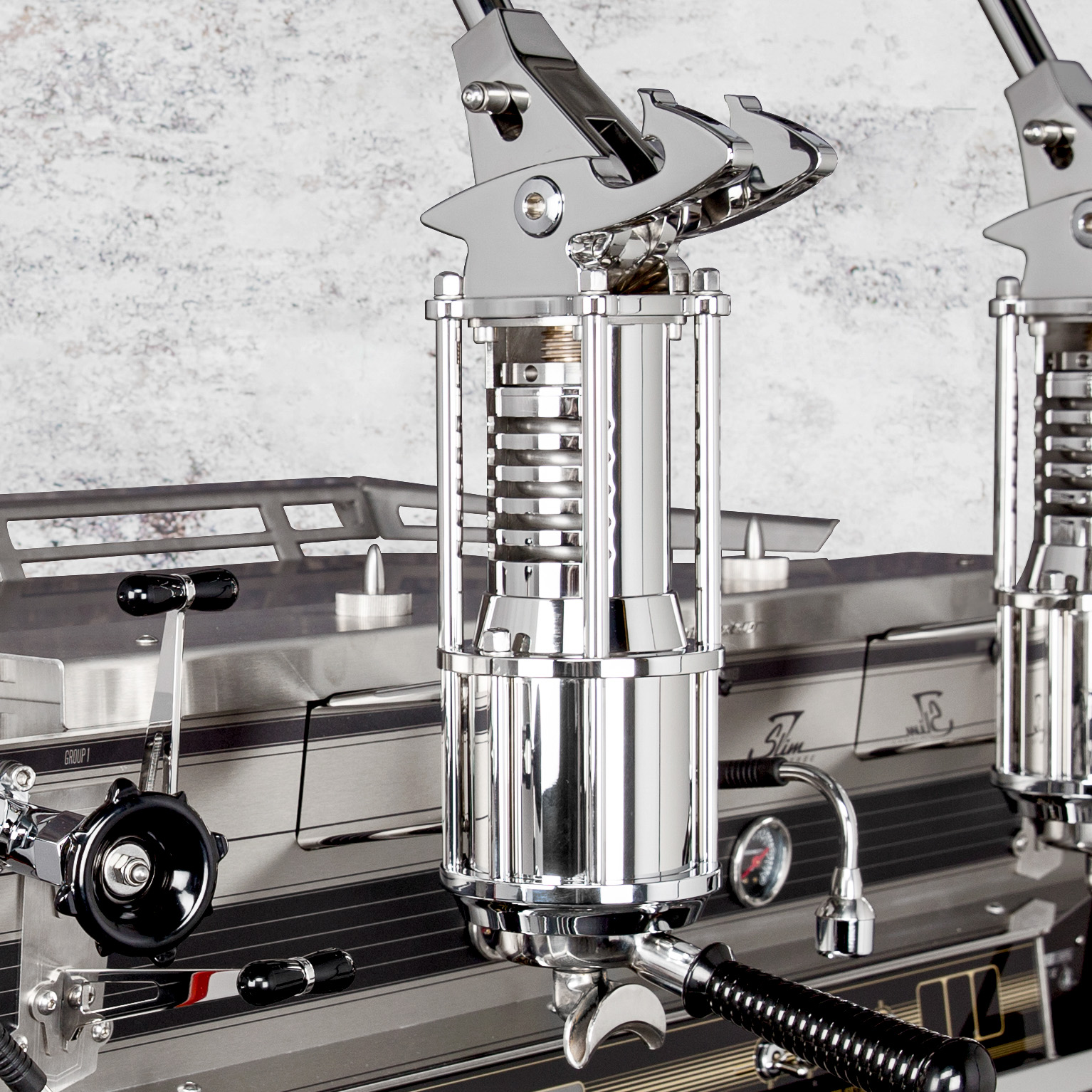
Q: You also mentioned a re-engineered lever system will be available for the Slim Jim lineup. I’ve often felt the lever design could be the most perfect way to brew espresso, but it needed major updates and evolution from the 1940s to 1960s designs we seem to have in the industry. What have you done to update and improve levers?
You are quite right. First and foremost: we took away the danger of the lever possibly hitting you when accidently bouncing back, by our proprietary locking mechanism.
Then we made sure temperature is extremely stable. The cylinder sits inside the saturated group. So unlike the classic groups the brewing chamber (created when you pull up the piston) is kept at the perfect temperature. The water around the cylinder will flow into the cylinder for brewing, so there is no loss of temperature at all. Together with our PEEK dispersion plate this makes sure the temp indicated is exactly what hits your coffee. No more guessing.
Additional improvements are ease of work: you can flush the screen by a small lever next to the group, no need to pull that big heavy lever. You can stop the extraction process at any moment by touching another small lever. For example when the flow starts to blond, or the group chokes because of too fine a grind. The pressure at the puck is released and the big lever slowly returns to its start position. This also does away with the sneeze when taking out the filter holder swiftly. You can now work quickly, no more waiting.
The pressure gauge indicates the real-life pressure at the puck. Together with the slowly moving large lever this provides good feedback on how your shot is developing. In addition, both spring pressure and initial infusion pressure are adjustable, and all parts are in stainless steel.
We are sure this new lever makes it a viable proposition in even busy shops. Next to produce the enjoyable coffee typically produced by lever groups of course!
Q: Will this lever group redesign make it to your other machine lineups, including the Spirit, the Speedster, and the Mirage?
No, that is not possible. The Spirit’s frame is not designed for the vertical forces created by pulling the spring loaded lever. Yet we did build Idrocompresso groups on the Spirit for a few machines a little while ago, with a lot of frame strengthening measures. However, this was an expensive project for this customer only, we won’t be offering it on the Spirit.
As for the Speedster, you’d pull the Speedster completely off of the table (if you attached this spring group). It lacks long legs at the front.
Regarding the Mirage, it has a completely different heating system. The new lever group uses the saturated group set-up (and wouldn’t work on the Mirage).
Q: When will we see Slim Jim machines in cafes? And will there be a single group version?
From 2019. Sorry, no Slim Jim one group.
Q: So I have to ask: Why “Slim Jim” as a name for the new machine line?
Well, first of all the machine is rather slender and elegant in shape.
Secondly, “Slim Jim” is an often used name. Think of a early Pontiac or Oldsmobile automatic transmission, a tool to break into cars, a name used by several jazz and blues musicians. I know it also is used for a US sausage and a trash can, but that simply adds to the wide cultural presence and diverse meanings of these two words. In all it has a solid sound to it.
The fact that you, and many others wonder, is a good thing for us!
Q: Last question… that was one sweet ride you have in that promotional video for the Slim Jim. Is that your car, and tell us what it is!
It is my daily summer ride, a 1964 Thunderbird. The optimistic, almost naive styling of the early sixties American cars has always appealed to me. People immediately smile when they see one. I have it for 20 years now. The road in the video is the very road I drive to work every day!
Have a look at some other photos of the forthcoming Slim Jim Espresso Machine lineup.





